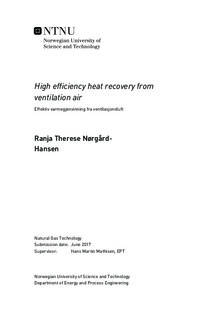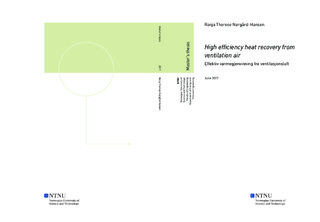| dc.description.abstract | The objective of this thesis has been to conduct both theoretical and practical work to investigate how to the calculations of effectiveness can be more representative.
A literature study regarding field test of heat recovery in ventilation air has been conducted. The main focus has been on the effectiveness concerning both thermal and moisture recovery. Measuring techniques for mass flow have been studied and presented.
Preliminary field tests have been conducted in Øya Kindergarten in Trondheim. An anemometer was used to measure both temperature and velocity. The results from measurements are presented and discussed. The effectiveness has also been calculated with the measured mass flow and temperature values with a result of >1. The results have been compared to heat balance ratio for validation and the uncertainty of the effectiveness of have been estimated. The calculated effectiveness that is based on measurements does no correlate with heat transfer theory or design data. The heat balance ratio confirms that the result is invalid.
The supply mass flow was estimated with the exhaust mass flow and the ratio between fan speed in the air handling unit (AHU). This results in an effectiveness of 81,5%, which corresponds to both theory and design data. The effectiveness of 81,5% for the heat exchanger is within the requirements in NS 3701 (2012), but slightly lower than the nominal efficiency given by the supplier. This result is based on assumptions and should not be credited as valid.
From the discussion of literature and results, velocity measurements can be a reliable method if it is measured in laminar flow. By establishing knowledge of the flow pattern in the ducts, the measurements can be conducted in the most suitable sites for determining mass flow. It comes forth that the velocities should be measured in the inlet ducts since the airflow is assumed to be turbulent in the outlet ducts, based on the results.
For further work, it is proposed to conduct measurements at several sites and use more than one unit for measuring and include latent efficiency. | |

